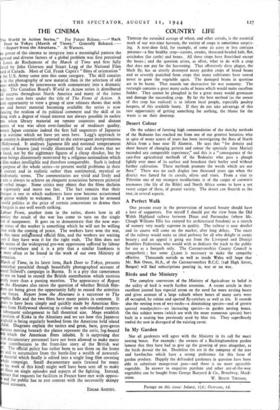THE CINEMA
'he World in Action Series." For Future Release. Back
Door to Tokyo (March of Time)." Generally Released. .. Report from the Aleutians." At Warners.
E power of the cinema to integrate into a meaningful pattern the persed and diverse factors of a global problem was first perceived Louis de Rochemont of the March of Time and. first fully used by John Grierson and Stuart Legg of the National Film ard of Canada. Most of Col. Frank Capra's "films of orientation" the U.S. Army come into this same category. The skill consists s in the photography of new material than in the selection of old nes which may be interwoven with commentary into a dramatic ole. The Canadian Board's World in Action series is distributed th success throughout North America and many of the items ye been seen here under the title of The Front of Action. A cot opportunity to view a group of new releases shows that with re and better material becoming available the series is now ancing the realism of its political comment and the skill of its *ting with a degree of visual interest not always possible in earlier s when library material on remote countries and distant atres of war was often over-familiar or of mediocre quality. rtress la pan contains indeed the first full sequences of Japanese in wartime which we have yet seen here. Legg's approach to t country is diametrically opposed to the extravagant interpretations Hollywood. It analyses Japanese life and national temperament terms of known (and vividly illustrated) fact and shows that we faced, not by the nightmare figures of a cheap shocker, but by an beings disastrously motivated by a religious nationalism which film makes intelligible and therefore conquerable. Such is indeed purpose of the whole series—to present world problems in their 1 context and in realistic rather than sentimental, mystical or lodramatic terms. The commentaries are vivid and lively and aim is always to achieve an eloquent association between pictorial • verbal image. Some critics may object that the films declaim vigorously and move too fast. The fact remains that their hnique is one to which audiences have now become accustomed • appear widely to welcome. If a new interest can be aroused world politics at the price of certain concessions to drama then bargain is one well worth striking.
abour Front, another item in the series, shows how in all nines the result of the war has come to turn on the single tor of manpower. It goes on to demonstrate that the new war- e status of the worker is something which he will not be willing lose with the coming of peace. The workers have won the war, s this most enliAtened official film, and the workers are waiting see if they have won it for the right ends. The film does not k scenes of the widespread pre-war oppression suffered by labour ost everywhere and it is a pity that a similar frankness is more often to be found in the work of our own Ministry of rmation.
arch of Time, in its latest item, Back Door to Tokyo, presents mewhat parochial though beautifully photographed account of neral Stilwell's campaign in Burma. It is a pity that cameramen e not on hand to record the British contribution which receives cely more than a passing mention. The appearance of Report the Aleutians also raises the question of whether British film- ers are being given the opportunity fully to record the activities our forces. Report from the Aleutians is a successor to The mphis Belle and the two films have many points in common. It ears to have been simply and quickly made by American film- ers from Hollywood shooting in colour on sub-standard cameras subsequent enlargement to full theatrical size. Maps establish Position of Kiska in the Aleutians and we see how this Japanese lighold is being regularly bombed from the American held island dak- Diagrams explain the tactics and great, bare, grey-green tains moving beneath the planes represent the eerie, fog-bound Id which the American fliers inhabit. It is surprising that tish documentary personnel have not been allowed to make many liar contributions to the front-line story of the British war 1. The official policy has rather been to use them on the home it and to accumulate from the battle-line a wealth of newsreel- material which finally is edited into a single long film covering hole campaign. Small documentary units (trained for many s for work of this kind) might well have been sent off to make rt films on single episodes and aspects of the fighting. Instead, Ppears that requests for facilities in France have met with opposi- and the public has to rest content with the necessarily skimpy reel accounts.
EDGAR ANSTEY.


























 Previous page
Previous page